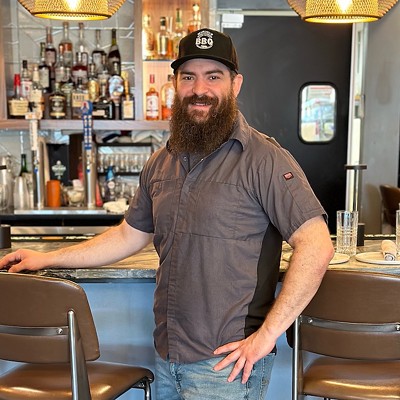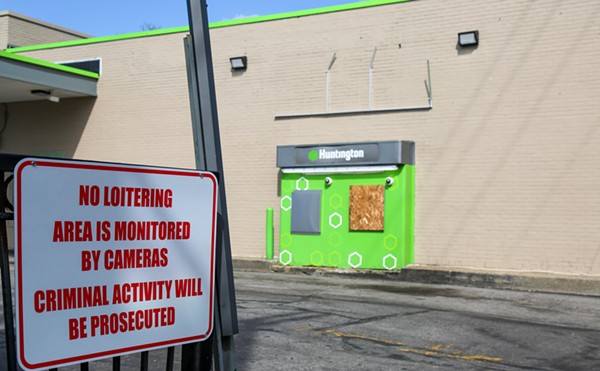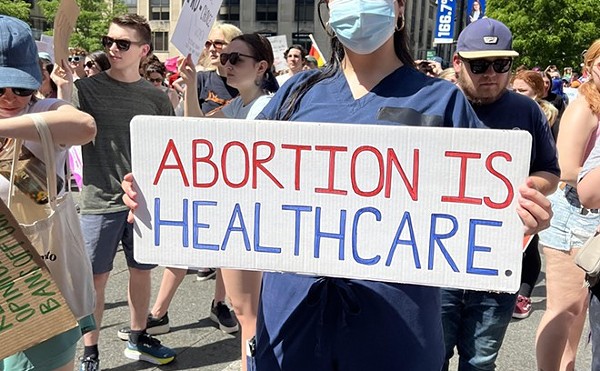Local zoning boards could prohibit the commercial sale of pot to patients within their municipal limits and could also forbid patients from growing weed in their own homes.
But to many, the most disconcerting provisions in the Treatment Amendment are that state and local lawmakers could pile whatever taxes or fees they see fit on the sale and cultivation of medical marijuana — and that local police departments would be responsible for enforcing the local laws.
Local control like this has caused problems elsewhere. In Colorado, thousands of local ordinances can be put on the books each year as individual cities initiate or change various restrictions. In Oakland, California, the cost of a license to cultivate medical marijuana has skyrocketed to more than $200,000, putting such businesses out of reach for individuals and non-profit groups.
"In some cases it's been a city just trying to make as much money as possible, but in some cases [high taxes or fees] are to keep away too many customers and dispensaries," says Fox. "They know only those serious about it will pay."
In Michigan, which legalized medical marijuana just two years ago, things are reportedly a mess. "The main trouble is that law enforcement in Michigan, by and large, doesn't believe in medical marijuana," Fox says. "Some law enforcement and community leaders are not interested in working with advocates and community organizations on how best to implement the policies."
Also lacking in the Treatment Amendment is a "medical defense" clause — a flaw that resonates loudly with Cannabis Act supporter Daniello. Immediately after she delivered her fifth child seven years ago, the Geauga County resident developed severe back pain. "I was more of a natural medicine type of person my entire life," she says. But her husband, an emergency room physician, eventually convinced her to see a doctor.
"They tried everything — neurontin, some kind of injections, and pain pills," she says of Cleveland Clinic specialists. "Nothing worked."
Before she knew it, she was addicted to percocet. "I was up to 12 a day," says Daniello, a youthful, petite 43-year-old who decorates her long auburn tresses with a braid made from yarn and a purple feather. She describes constantly impaired thinking that continued for three years while she took the drug, and she blames that impairment, at least partly, for the demise of her marriage.
Faced with a divorce and disgusted by the pain pills, Daniello threw them all away and instead tried pot, which alleviated the back spasms and pain. But a little more than two years ago, she was caught with half a joint.
"They took my children away," she says. "I don't want this to ever happen to any other mother."
Courts don't usually take children over misdemeanor pot possession. But in Daniello's case, she says, her estranged husband successfully used the charge in custody proceedings. After six months of negative THC tests, the children were returned, and Daniello has been relying on holistic pain relief techniques, like massage, ever since.
The irony, she says, is that nobody would have cared — and she wouldn't have lost the kids — if she had kept taking all that percocet.
The Cannabis Act would revive the old 1996 medical defense: Anyone charged with misdemeanor possession could escape the charge by producing a doctor's recommendation for weed after the fact.
The Cannabis Act differs from the Treatment Amendment in other substantial ways. It allows a registered patient to possess twice the weed (seven ounces) and allows licensed growers to produce twice as many plants. The list of ailments for which pot can be prescribed under the Cannabis Act would be best termed as more "all-encompassing." For one thing, the Treatment Amendment specifies "wasting" or "nausea," which could be side effects of HIV treatments; the Cannabis Act includes all HIV-positive people, whether or not they are taking anything for it.
"We are taking a different approach," says Cannabis Act spokesman Ben Morrison, 26, an untreated HIV-positive Cleveland Heights resident. He's also been diagnosed with a small bundle of cognitive and psychiatric problems, including attention deficit disorder, for which marijuana is quickly emerging as a remedy.
"Our focus is on patient privacy and using the existing regulatory structure," he says. The Cannabis Act would create a new state division, mirroring the Ohio Division of Liquor Control, which would limit state lawmakers' and local municipalities' control. Local lawmakers could opt out and prohibit commercial cultivators and medical marijuana dispensaries in their town, for example, but they could not prohibit state-registered patients from growing weed themselves.
The Cannabis Act also specifies that patient registration fees can't be more than twice the cost of a driver's license and that cultivation licenses cannot exceed the cost of a state liquor license. State tax on the sale of medical marijuana would be capped at 1 percent for dried plants and 2 percent for other medicinal products, like tinctures for tea and pot-laced foods. The state legislature would not have to dictate them.
Most important to Morrison and Daniello, though, is that enforcement would rest solely with the newly created state division. Only trained agents could inspect medical marijuana dispensaries, much as liquor control agents oversee Ohio's 477 liquor stores.
"Enforcement of the amendment is not with the local police departments," says Daniello, who tells tales of Denver police stations receiving a constant feed from the state health department detailing who is — or is not — a registered patient. "It's between the patient and doctor. It's nobody else's business," she adds, citing federal patient privacy laws. "Patients will not have to expect a knock on the door from armed officers."
But Treatment Amendment spokesman Maitland complained in a voicemail to Scene that the Cannabis Act would increase the size of Ohio's Constitution by 30 percent.
"It's very clearly something that's designed for commercial interests and not for medicine," he said. "We were just going to go ahead and be cool with everybody and let it slide, and just do our own thing and ignore them."
But not anymore. "We are now taking offense to what they are trying to do in Ohio. It's the most horribly written medical marijuana bill ever."
The Marijuana Policy Project, meanwhile, says the Cannabis Act has potential. "Legalized medical marijuana has generally worked better where it has been under state control," admits Fox.
But all parties agree that it would be very unlikely for both initiatives to wind up before voters. If both manage to survive the attorney general's office, only one is likely to raise enough money to successfully complete the massive task of getting the 385,000-plus voter signatures needed for a spot on the ballot. And according to Fox, politically savvy pro-pot organizations are more likely to fund the initiative that is most likely to pass.
But for now, it doesn't matter whether one signs an initial petition for the Treatment Amendment or the Cannabis Act. "Just be sure to sign one of them," Fox says. "Or both."
Changing Times
For years, Nelson Ledges was Ohio's answer to San Francisco's Golden Gate Park — only better, with its clear, deep swimming quarry and woods ideal for sequestering glassy-eyed partiers with their friends, music, and pot. Then came the 1980s and the War on Drugs.
At the annual Mid-West Reggae Fest, the music still resounds, barefoot dancers still prance about, and campers cluster together in the woods. But today, the haze in the air is mostly just mist evaporating from the cool water, and nobody cannonballing into it is naked anymore.
The glassy-eyed are still here, and the occasional waft from a joint floats past the nose, but it is more subdued these days. That doesn't stop a steady stream of revelers from finding their way to the NORML tent, where Neufer is collecting signatures for the Treatment Amendment.
Do they know there are two very different proposals afoot? Nope. Do they care? Maybe, but right now they just want to sign the petition. None seem to relate the medical marijuana initiative to their recreational use of the drug.
"It's only a misdemeanor already," says a thirtysomething Shaun from Toledo. "But my understanding is it's important that Ohio legalize medical marijuana because the more states that do, the better it is for getting the federal government out of the way."
"Yeah, it's silly," laughs a bystander. "The penalty for having a pipe or paraphernalia is worse than for having the pot!"
Another signer is John Visnauskas, executive director of All Faiths Pantry, a non-profit that delivers weekly groceries to 400 cash-strapped elderly and homebound residents in Parma and Brooklyn. "There are at least several people in our program that currently use marijuana for their symptoms. They're not kids; they're on Social Security. I do worry for them that they risk huge hassles in terms of their landlords or local law enforcement," he says. "With the stigma removed, I'm sure there would be more who would use it."
As a businessman, Visnauskas sees other advantages. "I imagine some of our individual board members would be interested in starting a non-profit that would cultivate medical marijuana for underserved patients," he says. "It would create jobs."
Meanwhile, Daniello and Morrison say they have seen no opposition to the Cannabis Act from anti-drug groups or anyone else. But they expect opposition will come, mostly from liquor manufacturers and lobbyists for pharmaceutical companies aiming to make millions from new pain drugs that will replace the percocet she blames for her own undoing.
When that opposition starts, the national organizations like NORML will have answers. One of their big guns is likely to be Lester Grinspoon, a Harvard professor of psychiatry and one of the medical community's loudest advocates for legalizing marijuana for four more than decades. At 83, he still occasionally invites students to gather around his volcano to talk about it.
"When I looked out my academic window of the '60s and saw all these young people destroying their lives with marijuana, and of course as a physician I knew all about drugs, I decided to write an article on how bad it was," he says. "My closest friend then was [astronomer] Carl Sagan. I told him he shouldn't use marijuana, that it was very bad."
But after researching the plant, Grinspoon changed his mind and became a student of weed's effects and properties. "It's quite safe," he says, noting that nobody in recorded history has died from it.
"The federal government continues to insist, obtusely, that marijuana is not a medicine. I think it will be the next wonder drug," he adds, now that large studies of its effects are being conducted in countries and states where it has been legalized. He sees a wide range of potential uses, and he's not hearing the view of physicians who disagree.
"They fall into the category of ignorant," he says.
As the sun sets behind the trees surrounding the quarry and the shade hits the NORML tent, Neufer says she has always agreed with the good doctor.
"I smoked a lot of pot. You know — I was in college. And I have never seen that it does anything bad."













